December
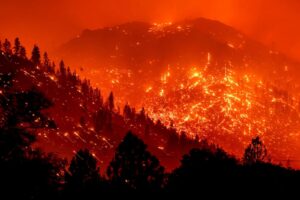
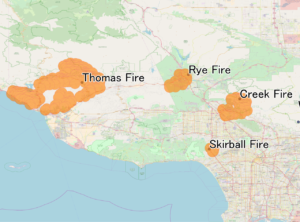 We all know that California is prone to wildfires. The hot Santa Ana winds stir up trouble every single year. Some years are worse than others due to dryer conditions. The year 2017 was one of those years. That year, in December, a series of 29 wildfires broke out across Southern California. Six of these fires escalated into major incidents, prompting extensive evacuations and significant property damage. The fires collectively incinerated more than 307,900 acres, leading to traffic jams, school shutdowns, dangerous air quality, and electricity blackouts, with over 230,000 individuals forced to evacuate. The Thomas Fire quickly grew to 281,893 acres, setting the record as the largest wildfire in contemporary California history, a record that stood until the Ranch Fire in the Mendocino Complex exceeded it the next year.
We all know that California is prone to wildfires. The hot Santa Ana winds stir up trouble every single year. Some years are worse than others due to dryer conditions. The year 2017 was one of those years. That year, in December, a series of 29 wildfires broke out across Southern California. Six of these fires escalated into major incidents, prompting extensive evacuations and significant property damage. The fires collectively incinerated more than 307,900 acres, leading to traffic jams, school shutdowns, dangerous air quality, and electricity blackouts, with over 230,000 individuals forced to evacuate. The Thomas Fire quickly grew to 281,893 acres, setting the record as the largest wildfire in contemporary California history, a record that stood until the Ranch Fire in the Mendocino Complex exceeded it the next year.
On December 5th, Governor Jerry Brown declared a state of emergency for Ventura and Los Angeles Counties, followed by San Diego County on December 7th. President Donald Trump went on to declare a State of Emergency for California on December 8th. The situation was already heading for a disaster, and these resources were going to be badly needed. The swarm of wildfires was intensified by exceptionally strong and persistent Santa Ana winds, coupled with abundant dry vegetation due to an unusually parched rainy season to that date. These fires also marked the culmination of an extraordinarily active and damaging wildfire season, resulting in at least $3.5 billion in damages, as well as, $2.2 billion in insured losses and $300 million in fire suppression expenses.
The initial report of the fire came in at 6:26pm on December 4th, just north of Santa Paula, close to Steckel Park and Thomas Aquinas College. The winds quickly pushed the blaze until it covered 12 miles of rural terrain into Ventura city. Within a few hours, it had destroyed nearly 500 homes, engulfing 50,000 acres. In the following days, it progressed toward Ojai, crossing Highway 33 and the Ventura River, reaching the Rincon Oil Field area. By December 8th, the Thomas Fire had expanded to 143,000 acres, with containment at only 10%, and the cost of battling the blaze was estimated to be at least $17 million. By the evening of December 10th, the Thomas Fire had expanded to 230,000 acres, now ranking as the fifth-largest wildfire in the modern history of California and the largest to occur in the state during December. It was moving so fast…at times, spreading at a rate exceeding one acre per second. It destroyed a minimum of 794 structures, damaged another 187, and incurred a fighting cost of at least $38.4 million, placing it among the top ten most destructive wildfires in California’s history. By the early hours of December 11th, the Thomas Fire had increased to 230,500 acres, with containment efforts reaching 15%. On December 13th, the Thomas Fire’s northwestern and southwestern flanks merged east of Carpinteria, covering an area that includes Ojai and Lake Casitas. By the early hours of December 16th, the fire had grown to 259,000 acres, with 40% containment, now overtaking the Rim Fire as the third-largest wildfire in California’s history. By December 19th, the Thomas Fire had expanded to 272,000 acres, with 55% containment, becoming the second-largest wildfire in the state’s modern history. On the evening of December 22nd, the Thomas Fire grew to 273,400 acres, reaching 65% containment and surpassing the Cedar Fire of 2003, making it California’s largest recorded wildfire. By December 24th, the fire had expanded to 281,620 acres, which was largely due to a back-burning operation merging into the fire’s northwestern flank, although the containment of the fire also rose to 86%.
Then, on January 8–9, 2018, what might have seemed like blessing…a winter storm hit California, causing heavy rainfall in Southern California and leading to mandatory evacuations in parts of Los Angeles, Santa Barbara, and Ventura Counties due to the risk of mudslides in wildfire-affected areas. The storm resulted in at least four inches of rain, triggering numerous significant mudflows. On January 12, 2018, the US Forest Service announced that the Thomas Fire was 100 percent contained, covering 281,893 acres. Nevertheless, officials from Los Padres National Forest kept watch over the Thomas Fire’s burn area for any remaining hotspots. By March 22, 2018, InciWeb reported the Thomas Fire as inactive and stopped updates. Nevertheless, they kept a vigil, before finally, officially declaring the fire extinguished on June 1, 2018, following over two months without any detected hotspots within the burn area’s boundaries.
In addition to the Thomas fire, 28 other fires raged across the area during that period. Causes of the fires varied, from lightning to illegal cook fires to arson. Roads and interstates had to be closed, and areas evacuated. The wildfires of December 2017 devastated vast tracts of land, leading to significant property damage. Moreover, they compelled the evacuation of over 230,000 residents from their homes. The Thomas Fire claimed the lives of two individuals: Virginia Pesola, a 70-year-old civilian from Santa Paula, and Cory Iverson, a firefighter engaged in combatting the blaze. “This is a tragic reminder of the dangerous work that our firefighters do every day,” stated Teresa Benson, Los Padres National Forest Supervisor, in a press release. “The Thomas Fire presents many unprecedented conditions and complexities, adding to the already challenging task of fire suppression.” The wildfires led to the destruction of vast areas of forest. The absence of tree roots, which normally help bind the soil, resulted in decreased ground stability, making the terrain susceptible to 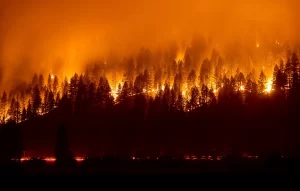
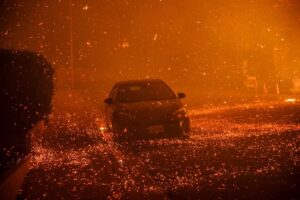 mudslides during heavy rainfall. In early January 2018, forecasts of significant rain for the American Southwest prompted the issuance of flash flood warnings and evacuation orders for parts of California that were impacted by the wildfires. In all 45 civilians and 2 firefighters lost their lives in these 29 fires. In addition, 199 civilians and 12 firefighters were injured, and 10,280 structures were destroyed.
mudslides during heavy rainfall. In early January 2018, forecasts of significant rain for the American Southwest prompted the issuance of flash flood warnings and evacuation orders for parts of California that were impacted by the wildfires. In all 45 civilians and 2 firefighters lost their lives in these 29 fires. In addition, 199 civilians and 12 firefighters were injured, and 10,280 structures were destroyed.
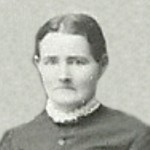 Years ago…September of 1976 to be exact, Bob and I went to Yakima, Washington to visit his great grandmother. While we were there, Great Grandma showed me a copy of a family tree, in the form of a real tree. As we looked it over, I noticed that Bob’s great great great grandmother’s last name was Spencer..the same as my maiden name. Susan Frances Spencer married William Elkins Cheshire on January 31, 1847, and their daughter Sarah Jane Cheshire married Joseph Leonidas Knox on March 4, 1875, and their son Edgar Allen Knox married Nellie Elizabeth DeGood (the grandmother who was showing me the tree) on December 25, 1907, producing Robert Leonidas Knox who married Nettie Landis Noyes, producing Joann Eleanor Knox who married Walter Andrew Schulenberg, producing Robert Walter Schulenberg, who married me on March 1, 1975.
Years ago…September of 1976 to be exact, Bob and I went to Yakima, Washington to visit his great grandmother. While we were there, Great Grandma showed me a copy of a family tree, in the form of a real tree. As we looked it over, I noticed that Bob’s great great great grandmother’s last name was Spencer..the same as my maiden name. Susan Frances Spencer married William Elkins Cheshire on January 31, 1847, and their daughter Sarah Jane Cheshire married Joseph Leonidas Knox on March 4, 1875, and their son Edgar Allen Knox married Nellie Elizabeth DeGood (the grandmother who was showing me the tree) on December 25, 1907, producing Robert Leonidas Knox who married Nettie Landis Noyes, producing Joann Eleanor Knox who married Walter Andrew Schulenberg, producing Robert Walter Schulenberg, who married me on March 1, 1975.
The only clue I have as to what Susan Frances Spencer might have looked like is her daughter Sarah Jane Cheshire Knox, shown here. I know that Susan married William Cheshire, and that her life was rather short. She was born January 30, 1830, in Jefferson City, Tennessee, and died at the age of 46 years, on May 26, 1876 in Caldwell, Missouri…just over 100 years before I would find out about her, and begin a quest to find out more about her, that would span 36 years to date.
The Spencer family, or at least the branch I come from kept extensive, detailed records, so I never dreamed I would have so much trouble locating a Spencer or their ancestors, but with Susan Frances Spencer and her ancestors, that has not been the case. The trail to find out more always seems to turn very cold right at Susan, and I am left with questions. Who was Susan Frances Spencer Cheshire? How did she die? Who were her parents?
Susan married very young. She was only 17 years and 1 day on her wedding day. Hers was a marriage that would only last 29 years, and would produce 10 children between 1847 and 1867. She did not die in child birth, so what happened. Was there some epidemic in Missouri in 1876? It’s possible since there was a Yellow Fever Epidemic in Georgia in 1876, but I can’t find anything saying that it spread to Missouri. Another dead end!!
I have to wonder if I will ever know if she was related to me. I suspect that she was, because most of the Spencer families seem to come from one branch or another of the same set of grandparents back in England. I would also like to know if back in Bob’s family history somewhere, we will find that he too, is related to the current royal family in England.
 Every year on February 9th, a small group of friends gather for breakfast at Johnny J’s Diner to talk about a little girl who touched all our hearts deeply, and left us far too soon. Brooke would have been 15 years old on December 24, 2011, but she passed away on February 9, 2004 from an acute asthma attack. I often wonder who she would have been today at 15 years old. She had such a bubbly personality and a smile and laugh that made it hard to ever tell her no…even if you should have. Her siblings knew how to get something they wanted, or do something they wanted to do…they just got Brooke to ask for it. The funny thing was, however, that she never seemed spoiled to me, or to anyone else that I know of. She was just sweet.
Every year on February 9th, a small group of friends gather for breakfast at Johnny J’s Diner to talk about a little girl who touched all our hearts deeply, and left us far too soon. Brooke would have been 15 years old on December 24, 2011, but she passed away on February 9, 2004 from an acute asthma attack. I often wonder who she would have been today at 15 years old. She had such a bubbly personality and a smile and laugh that made it hard to ever tell her no…even if you should have. Her siblings knew how to get something they wanted, or do something they wanted to do…they just got Brooke to ask for it. The funny thing was, however, that she never seemed spoiled to me, or to anyone else that I know of. She was just sweet.
Now, 8 years later, we still gather to talk about the little girl who meant so much to all of us…and to console her mother, who still struggles with that day, as well as the month of February and even from December 24th through February 14th, which was the day Brooke was laid to rest…a fitting day for a girl who was born on a holiday, and very much loved.
Of course, Brooke was never a mother, but in her short little life, she practiced for that role she dreamed of having by mothering every baby she ever came across. Her mom, Dani babysat my grandchildren, but it was Brooke who babysat my youngest grandchild…Josh. Dani could help…a teeny little bit, but not very much, because Josh was Brooke’s baby, and everyone might just as well get that fact through their thick head, because that was the way it was.
Brooke touched the lives of young and old alike. She had her very favorites though, like my husband, Bob for example. Whenever Bob walked into a room Brooke was in, she ran over to him and gave him a big hug. She was almost like a little girlfriend, and I might have been jealous, had it not been for the difference in their ages. She loved him so much, and it was very hard to be jealous of such a sweet little girl, so I had to be content to share 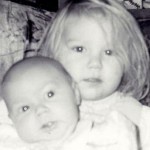 him whenever Brooke was in the room.
him whenever Brooke was in the room.
Now, 8 long years after her passing, we can each remember how she touched our lives, and I’m sure the stories will all be shared as we gather to look back on the life of a child that has been gone longer than she lived, and yet seems to still be so very much with us. Her memory is everywhere…every time we hear a child laugh, every time a little girl takes a shine to Bob, every time we see Madyson, Brooke’s little sister, who looks incredibly like her older sister…so much so, that I often call her Brooke. And so we gather to console her mother, and remember the little girl who touched our hearts.
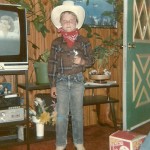 When our nephew, Barry was a little boy, he decided that he didn’t really like having his birthday on December 11th, because it was so close to Christmas. Many people with December birthdays feel the same way. It always seems like their birthday gets lost in all of the Christmas hustle and bustle, and they end up feeling gypped.
When our nephew, Barry was a little boy, he decided that he didn’t really like having his birthday on December 11th, because it was so close to Christmas. Many people with December birthdays feel the same way. It always seems like their birthday gets lost in all of the Christmas hustle and bustle, and they end up feeling gypped.
I’m not sure if it was in protest, or what exactly, but at some point, Barry decided to change things up a bit. Obviously your birthday is when it is, and you can’t change that fact, but Barry decided to forgo the gift part of it until his un-birthday came around. The date he chose for his un-birthday, was of course, June 11th, because that put it exactly 6 months later. His mom, my sister-in-law, Jennifer always said that the perfect birthday was June 25th, because it was exactly 6 months from Christmas, giving the person who had that perfect birthday, gifts exactly 6 months apart. Barry thought that was a pretty good idea, but his birthday just didn’t cooperate, so he settled for the un-birthday of Jun 11th.
I always thought that was such a funny idea, but very clever. I don’t think I would like having my birthday that close to Christmas, because I can see where it could be 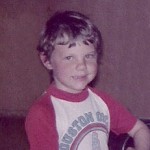 problematic for the birthday person. Still, I don’t know if I would have ever considered that it could be celebrated at a different time. Barry was definitely using his head when he came up with that idea…unless he had a little help from his mom, my sister-in-law, Jennifer, and that is entirely possible.
problematic for the birthday person. Still, I don’t know if I would have ever considered that it could be celebrated at a different time. Barry was definitely using his head when he came up with that idea…unless he had a little help from his mom, my sister-in-law, Jennifer, and that is entirely possible.
I don’t know if Barry still celebrates his birthday in June, but since today is his real birthday, I just want to say happy birthday Barry!! You have grown into a very special person, and we are very proud of you. And if you do still celebrate your birthday in June, I’ll try very hard to remember to wish you a happy un-birthday then.

